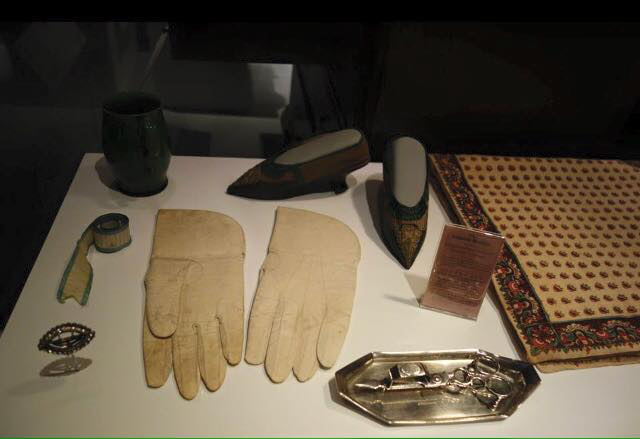Decoding the past, one item at a time
Eighteenth-century handwriting may be elegant, but it isn’t always legible.
A team of UW–Madison students has “decoded” a historic ledger and researched items for the Smithsonian’s American Enterprise exhibit, bringing to life a unique record of American life 250 years ago.
“At the start of the semester, I remember one of the students exclaiming, ‘It’s like a code!’” says Ann Smart Martin, a professor of art history who oversaw the project.
Kept by merchant William Ramsay, the left page of the book (marked “debtor”) recorded the date, customer’s name, what was purchased, and for how much. The right side listed when and how a person paid.
Using an interactive panel — something never before done in a museum — visitors can choose to learn more about each highlighted entry, the person who took part in the transaction and how that object was used in Colonial times.
Pieces selected for the final display include the following:

Photo: Ann Smart Martin
Clockwise from lower left
Paste (glass) buckle, researched by Sona Pastel-Daneshgar
Like handkerchiefs, fancy buckles were purchased by both men and women to adorn shoes and clothing in a variety of ways, though this particular ornate buckle was intended for a man. Ramsay’s ledger showed one “pair knee buckles” sold to a John Douglass. The cut glass stones are set in steel.
Ribbon, researched by Professor Ann Smart Martin
Ribbons were small but important objects with multiple connotations, particularly involving the relationships between men and women. “A black ribbon could be mourning or death, but another purchase could be from a young man to a young woman, bringing life,” says Martin. “Ribbons got this other meaning going on that actually could be kind of sexual, because you’re taking something and putting it around your body.”
Green earthenware mug, researched by Elizabeth Amherdt
Ramsay owned a ship called the Fairfax, which he unsuccessfully tried to sell in 1751, and the ship had its own account in the ledger. “We think it was used by the crew of the ship because it was charged to the account of the ship,” says Martin.
Pair of shoes, researched by Maddie Hagerman
An August 1753 entry listed eight pairs of “best shoes.” Buyer Vorlinda Wade, a wealthy widow, was sole owner of a large tobacco farm adjoining Mount Vernon. Hagerman and her fellow group members carefully researched shoes from the era to select a pair that most closely represented what a wealthy widow might have considered “best shoes.”
Tiny copy of Lilliputian Magazine; or, the Young Gentleman’s and Lady’s Golden Library, researched by Dani Zwang
“Far too many of the objects in the account are not identified with enough specificity, so we were thrilled that the merchant identified Lilliputian Magazine,” says Martin. “We now know that the earliest and most up-to-date forms of children’s literature in Alexandria was written by the most recent literary talent in the style of the fantastic travel yarns of Gulliver’s Travels.”
Printed handkerchief from India, researched by Shagun Raina
“Some of the textiles had enough detail so that we knew they came from India because of the names attached to it,” says Martin. “Sastracundy was a place in India known to be dyeing these textiles.” By tracing the story of an exported textile from India to the colonies, Martin says Raina’s team has illustrated the global story of how other countries and cultures make their way into the artifactual world.
Silver candle snuffer, researched by Abby Springman
“Although expensive and seldom squandered, candles were an important part of life in an urban place like Alexandria,” says Martin. “Candles required careful, labor-intensive watching and cleaning; the wick needed to be snipped to keep from melting extra wax, smoking or perhaps falling away on fire. The elegant little snippers were developed with a blade, a box to keep the bits and a tray.”
White leather gloves, researched by Anneliese McGavin
According to the display label written by McGavin, customers at Ramsay’s store bought a variety of British-made gloves like the white kid gloves purchased by Captain William McCarthy. Gloves made of elegant glazed lamb, fragile lace, or basic muslin protected the hands of both men and women. Complex codes of dress dictated what designs were appropriate.
Ramsay’s desk and bookcase
Due to Ramsay’s prominence, his will and many other important papers are available in the Smithsonian archives and became valued parts of the students’ investigation. His tall mahogany desk reveals the elaborate workmanship indicative of his success as a merchant; the weights and measures he used in his trade sit alongside the ledger itself.
Other items researched by UW–Madison students include:
- Combs (Stephanie Goodwin)
- Battledore (Drew Sanders)
- Button (Anna Lee)
- Candlestick (Anneliese McGavin)
- Children’s primer (Anna Lee)
- Copper tea kettle (Drew)
- Doll (Sona Pastel-Daneshgar)
- Fan (Shagun Raina)
- Fiddle strings (Monica Welke)
- Furniture hinge (Abby Springman)
- Glass bottle (Lauren Gottlieb-Miller)
- Knives and forks (Dani Zwang)
- Pewter chamber pot (Monica Welke)
- Pewter plate (Liz Jarvis)
- Pewter salt cellar (Stephanie Goodwin)
- Pewter spoon (Dani Zwang)
- Tea strainer (Elizabeth Amherdt)
- Thimble (Courtney Thrall)
- Whip (Nicole Kauper)
- White salt glaze mug (Nicole Kauper)
- Wig (Courtney Thrall)
Tags: arts, federal relations, humanities
